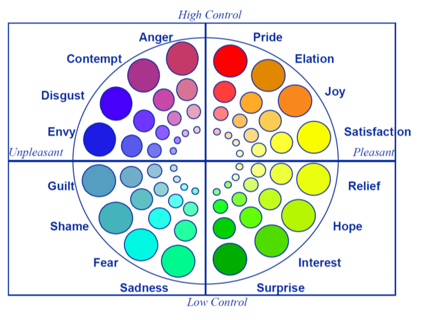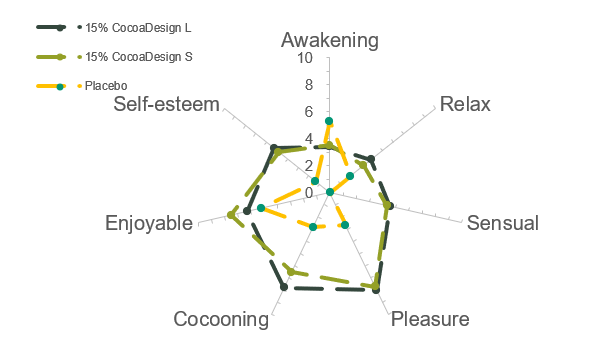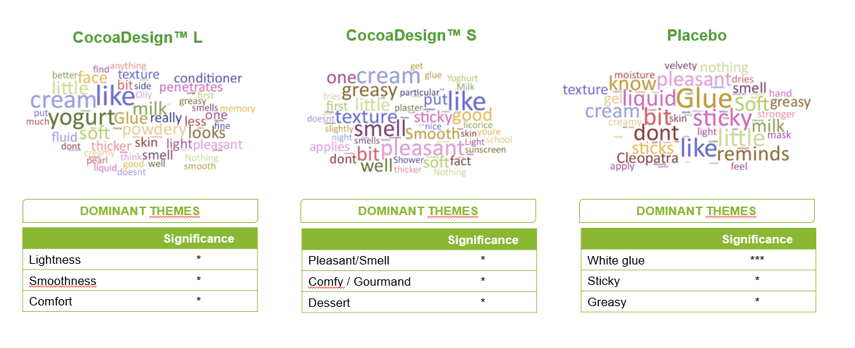CocoaDesign™, the new feel-good emollient
As consumers we are increasingly looking for products that can reduce the feelings of tension, stress and anxiety in our everyday lives. CocoaDesign™, a new cosmetic emollient family that’s derived from the cocoa bean is the perfect match to the quest we are looking for!
Designing a new emollient can be complicated considering the current offerings in the cosmetic market. Designing a new emollient through the lens of ‘Jobs To Be Done’ (1) changed our perspective at Cargill Beauty. In addition to the Function job of an ingredient, when designing a new emollient that meets the complete needs of the consumer, you need to add an Emotional job and a Social job in order to be successful.
With that in mind, here is how we designed our cocoa ethyl ester (CocoaDesign™ L) and hydrogenated cocoa ethyl ester (Cocadesign™ S) emollients according to the ‘Job To Be Done’ prism.
The key functional job of an emollient is hydrating and improving the skin barrier function to decrease water loss. Both CocoaDesign™ esters are shown to improve the hydration of the skin all day long. The Trans Epidermal Water Loss is also significantly reduced after one application.
But how could we add emotional job and social impact on our new emollients?
Consumers are increasingly conscious of the environment, and the social and ethical ramifications of consumption and production. Since 2012, Cargill developed and introduced a cocoa supply chain sustainability program called the Cocoa Promise. (2) This program is designed to enable farmers and their communities to achieve better incomes and living standards while growing cocoa more sustainably. In 2023, the Cocoa Promise program has had reached a significant social impact on local population by working with more than 240,000 local farmers. The crucial focus on protecting children’s rights, including access to quality education and working to monitor, identify and remediate instances of child labor, plus focus on empowering local women as entrepreneurs as central to the efforts, have made a positive impact on the local communities. The CocoaDesign™ esters are produced from cocoa butter, and using cocoa butter sourced through our Cocoa Promise program leverages our social impact of these two new emollients.
It's all about emotion.
Due to anxious and stressful day-to-day lifestyle of the average consumer, tapping into the emotional connection through use of beauty products has become a true customer need. In a recent study(3) it was found that 49% of US consumers experienced stress during 2023. In the same study, 71% of Gen Z and 58% of millennials said anxiety impacts their daily life. Most of the population is looking for solutions to reduce their feelings of tension, stress and anxiety. For example, 49% of Brazilian consumers would be interested in products that provide benefits to their mental or emotional health (4). If we consider our motivations related to food consumption, many of us can relate to experiencing the benefit of indulging ourselves by eating chocolate after coffee, or at the end of our day. Chocolate is a well-known source of positive emotional responses when used in food, particularly in confectionary. During the pandemic, Cargill’s chocolate business ran a survey on 7,485 persons from EMEA on their motivation to eat chocolate. The results showed that 48% of them will consume chocolate “When I feel like treating myself”, 32% “When I want to relax” and 25% “When I need a sugar boost / energy”. The objective of our CocoaDesign™ beauty study was to show that similar emotional benefits can also be produced using cocoa ester emollients in skincare applications.
Evaluating emotional perception.
A new method to apprehend the cognitive impact of cosmetics (5) from different perspectives has been introduced recently. This technique evaluates the emotional perception initiated through testing of a skin care cream using three different principles, including Verbatim ((i.e., semantic production) Analyses, Prosody, and Psychometric Scale (GEW = Geneva Emotion Wheel) (6). The analysis of the Verbatim corresponds to a quantitative approach (statistic) of the word content of the subject’s answers to the questions asked by the technician during the study. The Prosody consists of the vocal analysis (acoustic signal). It is used to distinguish between different emotional states. The prosodic analysis of emotion allows the assessment of the mean emotional response of subjects according to two main dimensions: valence (i.e., positiveness/pleasant vs negativeness/unpleasant) and arousal (i.e. activation/energizing vs deactivation/relaxing). The respondent is asked to indicate the emotion he/she experienced by choosing intensities for a single emotion or a blend of several emotions out of 20 distinct emotion families. The emotion families are arranged in a wheel shape (figure 1) with the axes being defined by two major dimensions of emotional experience:

Figure 1. Geneva Emotion Wheel (GEW)
Five degrees of intensity are being proposed, represented by circles of different sizes. In addition, "None" (no emotion felt) and "Other" (different emotion felt) options are provided.
The last emotional evaluation is based on the three methods: Verbatim, Prosody and Psychometric scale. It is a system of emotional characterization scoring seven main emotional dimensions from 0 to 10, such as: awakening, relax, sensual, pleasure, tender or cocooning, enjoyable and self-esteem.
Emotional evaluation of CocoaDesign™ emollients:
Study methodology
A panel of 31 healthy female volunteers (age group 25-55 y. old); Phototypes II to IV was selected. The creams (table 1) were applied on a single application on face and the study design was as double blind and non-comparative. 15% of CocoaDesign™ S or L are added to the placebo composition.
| Test product preferences: Placebo | 15% CocoaDesign™ L | 15% CocoaDesign™ S |
|---|---|---|
| Aqua/Water/Eau, Glycerine, Polyglycerol-3 Stearate, Glyceryl Stearate SE, Cetearyl Alcohol, Sclerotium gum, Sodium Stearoyl Lactylate, Benzyl alcohol (and) Salicylic acid (and) Glycerin (and) Sorbic acid, Sodium hydroxide | Placebo + 15% CocoaDesign™ L |
Placebo + 15% CocoaDesign™ |
Table 1. composition of the formulas tested.
The sequence of evaluation is divided into 4 parts:
- One open question to measure the Prosody baseline.
- Application of the product.
-
Two open questions for Prosody and Verbatim analysis:
“What does the texture make you think of?”
“What images or memories does this texture evoke for you?” - Questionnaire for the Psychometric scale (GEW).
The combined results of the Prosody and Verbatism analysis as well as the Psychometric scale allowed us to define the emotional signature of our CocoaDesign™ through emotional score.
Verbatim results
Without addition of our CocoaDesign™ emollient, the panel expresses Verbatim evoking “white glue, sticky and greasy” (figure 2). On the contrary, the addition of 15% of the emollient in the cream composition shifts the emotion and the wordings of the panel. For CocoaDesign ™ L cream, the most common words used are “lightness, smoothness, and comfort”. Considering the CocoaDesign™ S the impressions evoked are “pleasantness, gourmand or dessert”.
Figure 2. verbatim used by the panel on after application of each cream. Statistical significance: ns= non-significant, p≤0.05 *, p ≤0.01 **, p ≤0.001 ***
Prosody results
Furthermore, the prosody analysis showed that both CocoaDesign™ emollients brought a pleasant texture and positive emotion to formulations. CocoaDesign™ significantly shifted emotion from “Unpleasant” to “Pleasant,” with an arousal of “slightly energizing” reported for CocoaDesign™ S and “slightly relaxing” for CocoaDesign™ L.
Emotional signature of CocoaDesign™
From the combined analysis through emotional scoring matrix, CocoaDesign™ L and CocoaDesign™ S evoke more positive emotions than the placebo including Relaxing, Sensual, Pleasure, Cocooning, Enjoyable and Self-Esteem. (Figure 3)

Figure 3. Emotional characterization results after application of each cream.
Surprising link between food and cosmetic on Cocoa
Due to stressful environmental effects, consumers will look at different ways to treat themselves. In cosmetics, the tissue mask trend reveals that consumers are spending more time pampering themselves. Looking to introduce new sensorial and new experiences, we’ve designed two emollients from our Cocoa Promise cocoa. From blinded study, where the panel doesn’t know what is inside the cream, each of the two cocoa esters have revealed different Verbatim shifts, demonstrating that each emollient has a genuine and distinct impact on the perception of the product tested. Both of our CocoaDesign™ emollients evoke more positive emotions as compared to that of the placebo. Surprisingly, this blinded study of our cocoa emollients in a cream application demonstrates similar emotional responses to that of consumption motivations of chocolate that were observed in the Cargill food study previously described: relax, energy, treating myself.
Moving forward
Besides the skin benefits brought by CocoaDesign such as hydration properties and skin barrier, CocoaDesign triggers emotions because of personal memories or connection of cocoa to our experiences. With two new emollients developed using Cocoa Promise cocoa butter, we connect consumer perception to that of positive emotion. CocoaDesign™ L and S capture the three dimensions of ‘Jobs To Be Done’ needed for a successful product, including the Functional job, the Social job and the EMOTIONAL job.
[1] Clayton Christensen: The Theory of Jobs To Be Done
[2] www.cargill.com/sustainability/cocoa/previous-cocoa-promise-reports
[3] The State of Mental Health 2023, Ramsey Solutions
[4] Mintel 2023 Beauty & Personal Care Trends
[5] Bouhout S., Aubert A., Vial F., Choquenet B., Physiological benefits associated with facial skincare: Well- being from emotional perception to neuromodulation; Int J Cosmet Sci. 2023;45:458–469
[6] GEW; Scherer, 2005; Scherer, Fontaine, Sacharin, & Soriano, 2013


